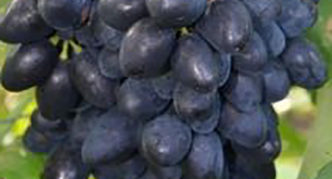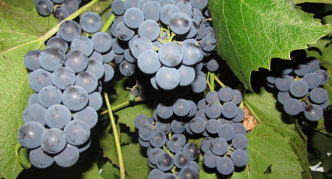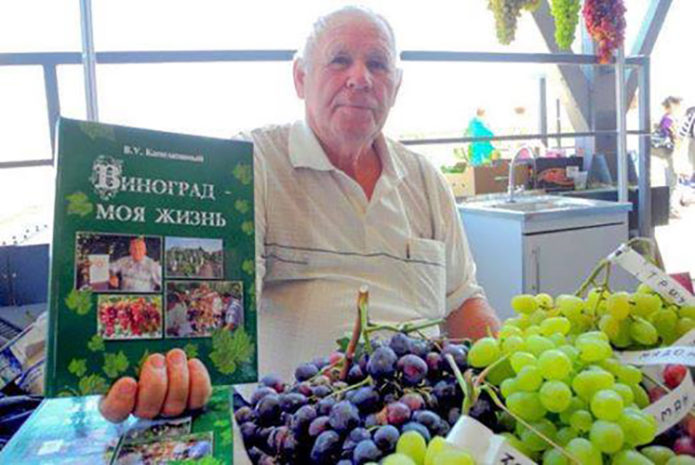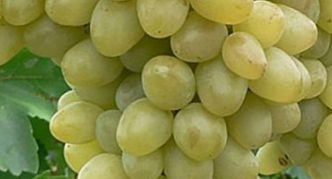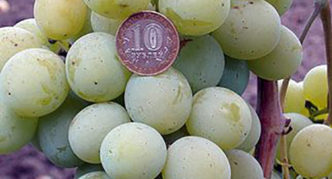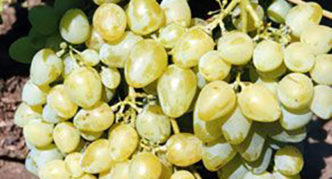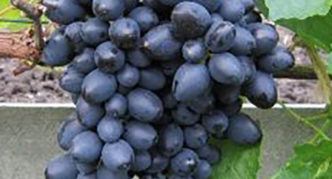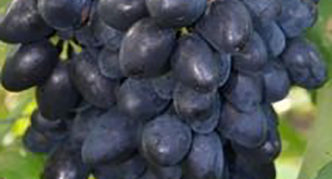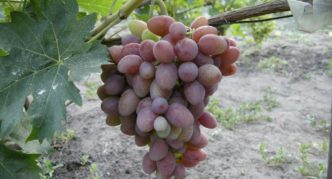Hope is one of the most beautiful human emotions that should always be in the soul. Winegrowers can have three of them at once - AZOS, Aksai and early. After all, these are the names given to grape varieties, each of which is interesting in its own way.
Content
Meeting the Three Hopes
Each of the Hopes is special and good in its own way. Two of them are brunettes - AZOS and an early one - black grapes, Aksai - a bright blonde - white grapes.
Nadezhda AZOS
Nadezhda AZOS is widely known and popular with winegrowers, bred at the Anapa zonal experimental station of viticulture and winemaking. Only she out of three passed tests in the Federal State Budgetary Institution "State Variety Commission" and in 1998 was included in the state register as recommended for growing in the North Caucasus. Its originator is the North Caucasian Federal Scientific Center for Horticulture, Viticulture, Winemaking.
Nadezhda AZOS was bred from a parental pair of the well-known and popular grape varieties Cardinal and Moldova.
What Nadezhda AZOS and her parents look like - photo
- Grapes Nadezhda AZOS
- One of the varieties of the parental pair of grapes Nadezhda AZOS
- Grapes from a parental pair of grapes Nadezhda AZOS
It has a dining function. The grapes grow on strong, vigorous bushes. This Hope has flowers with functions of both sexes. The bunches ripen on average 120–130 days. They are large, branched. Their average weight is about 0.5 kilograms. The dark, almost black oval grapes in them are loosely collected and weigh from 6 to 8 grams. They are covered with a dense crispy skin. Fleshy pulp poured with juice with a simple pleasant taste sweet and sour - sugar contains 14%, acids about 10 g / l. She earned 8.2 points from the tasters. Nadezhda AZOS gives good harvests. From one hectare of vineyard, you can get from 80 to 153 centners of fruit. This dose is very little susceptible to powdery mildew (mildew and mildew), and average resistance to gray rot.
The best fruiting of Nadezhda AZOS was recorded when it was grown on a vine formed as a one-shoulder cordon. A vine stem is formed with a height of 110-120 centimeters, and the shoots are left hanging freely.
It is recommended to load the bush with 25-30 shoots, which are cut short in autumn, leaving 2-4 eyes.
Nadezhda AZOS is not very adapted to withstanding the winter cold. Temperatures below -22 ºС are fatal for her. In areas with harsh winters, it must be carefully covered.
Nadezhda AZOS - video
Reviews about the variety Nadezhda AZOS
I got Nadezhda AZOS a very long time ago, when she was not just a deficiency, but few knew that there was such a thing ... The manager gave her to me. Anatoly Afanasyevich Brodenko Anapskiy GSO.By that time I was growing Rusbol, and after seeing the harvest and berries for 2 years, I decided to re-graft it with Nadezhda AZOS. On Rusbola, it turned out to be completely different, the berry is very large (if on a drop with feeding it is not inferior to the Monarch), the bunches are large up to 3200 g, the crop pulls up to 45 kg from the bush (planting pattern 2.5, m by 2.5 m, single row trellis), True, the ripening period increases, depending on watering. It happened on September 20.
Nadezhda Azos - opening of the season / year. Very, very sweet, the consistency of the pulp is marmalade, but I do not have enough acidity in it.
I am a beginner winegrower. This year I received the first bunches of Azos. Colored early, became tasty only in September. Everyone liked both the pulp and taste. Stored well. In the spring, I cut a stalk into two buds, stuck it in the ground between two bushes - it takes root (under the eggplant) and grows. What else is needed, awesome variety. I went to one of the grapes at the end of August to try varieties. Of the many vaunted varieties, there is no taste, or the wasps beat (gospel). So I will consider Azos as one of my main varieties for now.
Nadezhda aksai
Aksay Nadezhda was created by the most talented Don grape breeder and farmer Vasily Kapelyushny, who, unfortunately, left us in May 2017.
Vasily Ulyanovich received Aksai Hope from the wonderful parents of Talisman and Arcadia.
What Nadezhda Aksayskaya and her parental couple look like - photo
- Grapes Nadezhda Aksayskaya
- One of the parent varieties of Nadezhda Aksayskaya
- One of a pair of parent varieties of Nadezhda Aksayskaya
The resulting grapes are table grapes, tasty, and when fully ripened in 110–115 days, they show a light nutmeg. Bushes, the flowers of which are bisexual, give their strength not so much to the growth of shoots as to the cultivation of loose clusters. They mature large and even very weighty - 700-1200 grams, or even 2 kilograms. They can stay on the bush for a long time, becoming only sweeter.
Oblong yellow-green grapes, their components, are not small - 8-12 grams each. The skin of the berries, although dense, is not felt in food. The sour-sweet taste of Nadezhda Aksayskaya grapes is determined by 16–18% of sugar accumulated by berries and 6–7 grams of acid in a liter of juice.
The originator tested his variety for ten years on a hundred bushes. From an adult vine, he removed up to 40 kilograms of harvest. Such a result can be obtained by normalizing the number of shoots on the bush, inflorescences and clusters on each of them. Then the yields will be stable.
With annual autumn pruning, 2-4 eyes are left on the shoots, and up to 35 in total on the bush.
The shoots of Nadezhda Aksai ripen well, but the vines can withstand the winter cold only up to -23–24 ºС. It is recommended to shelter this variety from frost if temperatures below -16 ºС are likely in the area of its cultivation.
The variety is only relatively resistant to both types of powdery mildew and gray rot, therefore one or two preventive treatments are recommended throughout the season, especially if the year is rainy.
Nadezhda aksaysaya - video
Winegrowers' reviews about the variety Nadezhda aksayskaya
Nadezhda Aksai has a light nutmeg in her taste and at the first fruiting there were 4 clusters on the bush and they looked like the end of July. Personally, my opinion is still on the basis of the first indicators, I think it is worth stirring up. the vine in this form is fully ripe. and ARKADIA (Nastya) by half.) let's see what will happen next, if you believe KAPELYUSHNY VASILY ULYANOVICH, he has this form for 10 years and in plantings up to 150 bushes. Is it really bad that they plant?
Good health to all! On 2, 3 and 4 August she stayed with the Kapelyushnykh. I looked and tasted all the grapes. AKSAYSKAYA HOPE is fully ripe, wholesalers take it with pleasure - bunches of more than 2 kg., Beautiful color, excellent taste.ARCADIA on the same site is not ready yet. I was convinced once again - you need to believe yourself. Good luck to all.
Early hope
This grape of a very early ripening period of 95-100 days was bred not so long ago by an amateur breeder Anatoly Golub from the Dnieper. There are already several dozen bred grape varieties in his arsenal.
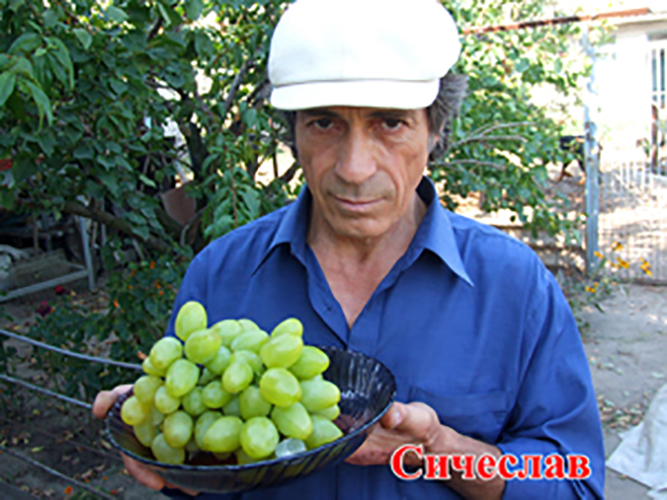
Anatoly Alekseevich received Early Hope from a beautiful pair of varieties ZOS-1, which is also called ZOSEY or Red Delight, and Nadezhda AZOS
I have been growing grapes for over 20 years. He started breeding 7 years ago. I set a goal to single out varieties from new hybrid forms that are not damaged by a wasp and are resistant to cracking when the soil is waterlogged, G.F. with a very large berry and a good harmonious taste. In the course of seven years of work, from a large number of seedlings, only a few hybrid forms were selected that meet my requirements. The seedlings were grown in Spartan conditions, in the open field. No growth stimulants were used. No agrotechnical measures were taken. I am satisfied with the results I have received over the years! All berry sizes are real and on a high agricultural background the berries and clusters will be even larger.
Anatoly Alekseevich received Early Hope from a wonderful pair of varieties ZOS-1, which is also called ZOSEY or Red Delight, and Nadezhda AZOS.
What the grape family of Nadezhda early looks like - photo
- One of the varieties of the parental pair of Nadezhda early
- Early hope
- One of the grapes of the parental couple of Nadezhda early
Their brainchild Nadezhda early turned out to be so fruitful that the load of the bush with bunches must be normalized. In addition, she is practically not afraid of wasps and powdery mildew. Its resistance to phylloxera is somewhat lower. Early Nadezhda is not very resistant to cold weather, only -23–24 ºС, so it can be grown in areas with cold winters only using a covering method.
Grapes respond well to timely watering and feeding, but prefers fertilizers with a low nitrogen content.
Early hope - a hybrid form of grapes with a dark color of berries. Its medium-sized bushes have bisexual flowers, so there are no complications with pollination. Large winged clusters of Nadezhda reach a kilogram or even more weight. Oval, dark blue, elongated, purine-coated berries are loose. They can weigh up to 14 grams. The grapes poured with juice are covered with a moderately thick, dense skin, which is eaten when eaten. The berry taste is pleasant with fruity nuances. Grapes do not crack, are not damaged by wasps, thanks to the dense skin, they can stay on the vine for a long time, additionally picking up sugar. The harvested crop is well stored, without spoiling, it is transported without problems.
Nadezhda early is resistant to common grape ailments, as well as to most pests.
Early hope - video
Winegrowers' reviews about early Hope
Early Hope - a hybrid form of grapes - very early ripening, in 2008, ripened on July 26. Hangs for a very long time, on the bush without losing marketability. The berry is large and very large, ovoid-oval, with a pleasant simple taste. The pulp is fleshy and juicy, the black taste lasts until autumn. Not prone to cracking, wasp is not affected. No peeling was observed during fruiting. The flower is bisexual, the stability during observation is good, the yield is stable. High. The pulp is black. Several tones in taste. Hangs without losing its taste until frost.
Cultivating Hope - Similarities and Differences
In planting and growing all three varieties of Nadezhda, there are common features and specific features of each variety.
Landing
Planting all three Nadezhd is no different from this operation for other grape varieties. A landing pit is being prepared in advance. In 2-3 months, the soil in it will be compacted, and the roots of the grapes will not fall into the voids.In a hole, the diameter and depth of which, depending on the grape planting area, can be from 0.5 to 1 meter, a support stake is driven in the center and filled in layers.
- On dense soils that do not allow water to pass through well, a 10-centimeter drainage layer is made first, consisting of crushed stone or fine gravel with sand.
- Further, regardless of the soil, three layers are poured approximately the same thickness as the first: fertile soil, humus and again fertile soil. Mix them thoroughly.
- The pit is filled with fertile soil, but not to the very top, leaving a recess for irrigation, into which 2-3 buckets of water are poured.
When it comes time to plant grapes, in the center of the prepared planting pit, soil is chosen so that the roots of the plant are freely located in the hole. They are straightened on an earthen mound poured inside, carefully covered with earth and tamped down. Water the plant with warm water in a volume of 2-3 buckets. When the soil absorbs water, a layer of humus, sawdust, cut grass, and other organic matter is poured around the planted grapes. This is called mulch. It will protect the soil under the grapes from drying out and compaction during watering and rains, and itself, gradually rotting, will become an additional fertilizing of the plant.
Since all three varieties of grapes under consideration have a low winter hardiness, it is better to plant young plants in spring.
Pruning
Autumn pruning of vines is one of the most important operations for:
- ensuring the normal growth and development of plants;
- getting a decent harvest from them;
- preparation of grapes for wintering.
Although in general it is carried out according to the general rules for the formation of grapes, for each of the varieties it has its own characteristics.
For Nadezhda AZOS, they recommend short pruning, that is, 2–4 eyes should be left on the shoot, there should be no more than 45 of them on the bush.
It is recommended to cut off the Aksai hope by 2–8 buds on the shoot and leave them no more than 35 on the bush.
For Nadezhda early - a very young and not fully studied variety, no clear recommendations have been found, one should adhere to the general method of pruning grapes, given that the bush is medium-sized.
Load regulation
All three Nadezhda grapes have large bunches. For their timely and high-quality ripening, and therefore for the berries to acquire the appropriate taste for the variety, to prevent peas, it is recommended to leave no more than one bunch on the shoot. Although some experienced growers, providing a high level of agricultural background, successfully grow two brushes. In any case, the number of bunches on the shoot must be normalized.
In addition, crop-laden vines should be well tied to the trellis so that the shoots do not break off.
Watering
As with other grape varieties, Nadezhda needs three watering season mandatory ones for successful growth and fruiting: before flowering, after it, and after harvesting. In the periods between these stages of plant development, the need for additional watering is consistent with the weather of a particular season. In areas where winters are cold, so-called charging watering is often carried out in the fall after pruning the grapes and before sheltering it for the winter. It allows the plant to endure frost more easily.
Disease prevention
Of the three Nadezhd, the least resistant to the main diseases of grapes is Nadezhda Aksai. One or two preventive fungicide treatments will only be beneficial to her. They are especially relevant in a bad year. In this situation, they will not harm the other two Hopes. They are carried out during certain periods of the growing season of grapes:
- before blooming flowers;
- after flowering;
- when the forming berries reach the size of a pea.
Preparing for winter
All three Nadezhda have almost the same frost resistance. Therefore, when growing them for the winter, it is better to remove them from the trellis, bending them to the ground and wrapping them in hay, straw, and other shelter materials.Polyethylene is fixed on arcs on top of the covering materials, the edges are sprinkled with earth, leaving gaps for ventilation. In this form, the vines will be able to withstand the winter cold.
You can remove the cover after the final melting of the snow. It is better to do this on a cloudy day or in the evening, so that the spring sun does not burn young shoots.
Let's compare our Hopes
Any comparative assessment of grape varieties is always subjective: what one considers an advantage, another may consider a disadvantage. For example, for some, nutmeg aroma is a positive quality of grapes, others do not tolerate it. There can be many examples of a completely opposite assessment of a particular quality inherent in a variety. To draw up a more objective assessment, you can summarize the qualities inherent in varieties in a table:
| Nadezhda AZOS | Nadezhda aksai | Early hope | |
| Maturation | 120-130 days | 110-115 days | 95-100 days |
| Bunch weight | 0.5KG | 0.7-1.2 kg, individual up to 2 kg | 1 kg and more |
| Grape weight | 6-8 g | 8-12 g | 14 g |
| Taste | sweet with light nutmeg | sour sweet | with fruity nuances |
| Sugar | 14% | 16–18% | information not found |
| Acid | 10 g / l | 6-7 g / l | information not found |
| Highest tolerated frost | -22 ºС | -23–24 ºС | -23–24 |
| Disease immunity | slightly susceptible to powdery mildew (mildew and mildew), gray mold resistance is average | to both types of powdery mildew and gray rot, the variety is relatively resistant | stable |
| Cracking with excess moisture | Yes | information not found | not |
| Wasp damage | slightly | Yes | not |
| Harvest storage | until early January | Yes | Yes |
| Harvest transportation | yes (matured in dry weather) | Yes | Yes |
But even considering these data, it is impossible to say to one of the Nadezhda "the most beautiful". Each person will choose one or another of them based on local conditions, climate, their experience of viticulture, and just their tastes and preferences.
They say there is no comrade for taste and color. It is impossible to say which of the Hopes is better or worse. The main thing is that all three varieties, regardless of the time of their creation, have already won the attention of many who are engaged in viticulture, growing vines for themselves or starting their own business on it.
